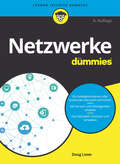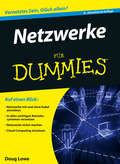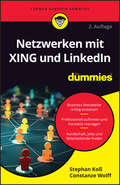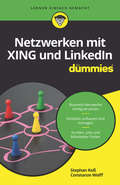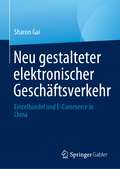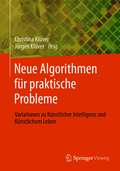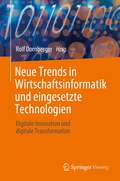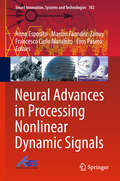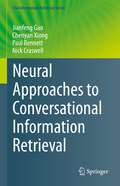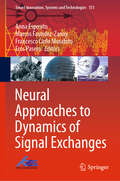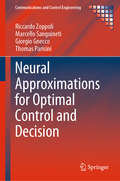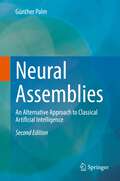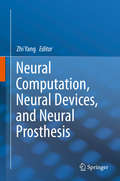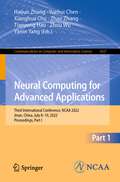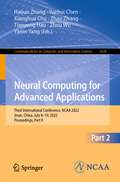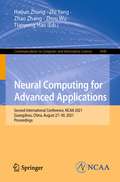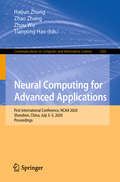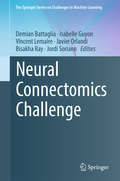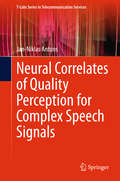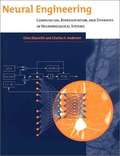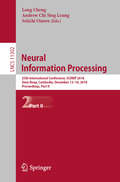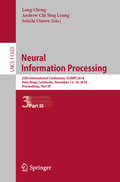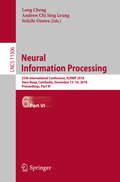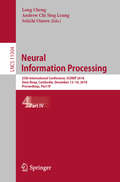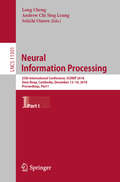- Table View
- List View
Netzwerke für Dummies (Für Dummies)
by Doug LoweWollen Sie ein Netzwerk einrichten? Einem Kollegen Ihre Dateien auf einfache Art zugänglich machen? Den Drucker gemeinsam mit der ganzen Familie nutzen? Alle Mitarbeiter auf die Kundendatenbank zugreifen lassen? Dieses Buch hilft Ihnen bei der Installation, Konfiguration und Administration Ihres ersten Netzwerks, ganz egal, ob Sie zu Hause ein Heimnetzwerk einrichten oder beruflich als Systemadministrator einsteigen wollen. Klären Sie zunächst ein paar grundsätzliche Fragen: LAN oder WLAN? Welches Betriebssystem? Und dann geht es ran ans Netz: den Drucker ins Netz bringen, Benutzerkonten einrichten, den Mail- und Web-Server konfigurieren. Und natürlich geht das Buch auch auf Cloud Computing, die Integration mobiler Geräte, auf Netzwerksicherheit und auf virtuelle Maschinen ein.
Netzwerke für Dummies
by Doug Lowe Gerhard FrankenWollen Sie ein Netzwerk einrichten? Dieses Buch hilft Ihnen bei der Installation, Konfiguration und Administration Ihres ersten Servers, ganz egal, ob Sie ein Heimnetzwerk einrichten oder beruflich als Systemadministrator einsteigen. Doug Lowe unterstützt Sie bei der Entscheidung zwischen LAN und WLAN sowie der Auswahl des Betriebssystems. Und dann geht es ran ans Netz: den Drucker ins Netz bringen, Benutzerkonten einrichten, den Mail- und Web-Server konfigurieren. Das Buch behandelt verschiedene Client-Server-Systeme: Windows, Mac und Linux. Und natürlich geht Doug Lowe auch auf Netzwerksicherheit, virtuelle Maschinen, Cloud Computing und die Integration mobiler Geräte ein.
Netzwerken mit XING und LinkedIn für Dummies (Für Dummies)
by Stephan Koß Constanze WolffDas Einmaleins des professionellen Netzwerkens Professionelles Netzwerken ist mehr als die Erstellung eines Profils bei XING und LinkedIn. Stephan Koß und Constanze Wolff helfen Ihnen, das Potenzial von XING und LinkedIn auszuschöpfen. Beginnend bei der Registrierung geben die beiden Ihnen Tipps zum Kontaktmanagement, erklären, wie Sie ein Unternehmensprofil anlegen, sich als Profi positionieren und spannende Inhalte oder Kontakte finden. So lernen Sie, wie Sie XING und LinkedIn wirkungsvoll für Ihre Zwecke nutzen – egal ob Sie selbstständig sind, im Marketing oder Vertrieb angestellt, einen Job suchen oder sich als Arbeitgeber präsentieren möchten. Sie erfahren Was professionelles Netzwerken ist Wie Sie ein Business-Profil aufbauen Wie Sie Kundschaft, Inhalte, Jobs oder Mitarbeitende finden Wie Sie sich als Profi positionieren
Netzwerken mit Xing und LinkedIn für Dummies (Für Dummies)
by Constanze Wolff Stephan KoßNutzen Sie Xing und LinkedIn, um im Beruf weiterzukommen? Ja? Sind Sie sich sicher, alle Möglichkeiten dieser Netzwerke richtig zu nutzen? Nein? Dann hilft Ihnen dieses Buch. Stephan Koß und Constanze Wolff erklären Ihnen, was professionelles Netzwerken überhaupt ist und wie Sie das Potential von Xing und LinkedIn ausschöpfen. Sie führen Sie ein, beginnen mit der Anmeldung, geben Tipps zu Kontaktmanagement und Suchen, erläutern, wie Sie ein Unternehmensprofil anlegen, sich als Experte positionieren, Jobs, Mitarbeiter und Inhalte finden und vieles mehr. So gibt Ihnen dieses Buch Anregungen, je nachdem wofür Sie Xing und LinkedIn nutzen wollen, als Selbstständiger Jobsuchender, Marketing-/Vertriebsexperte oder Arbeitgeber.
Neu gestalteter elektronischer Geschäftsverkehr: Einzelhandel und E-Commerce in China
by Sharon GaiDieses Buch bietet Geschäftsleuten und Wissenschaftlern einen praktischen Leitfaden für den chinesischen E-Commerce-Markt. China ist ein Einzelhandelsmarkt mit einem Volumen von 5,6 Billionen Dollar und hat die höchste E-Commerce-Durchdringungsrate der Welt. Aufgrund der COVID-19-Pandemie investieren Marken verstärkt in die Steigerung ihrer Online-Verkäufe. Das Buch soll den wachsenden Bedarf von Unternehmern und Unternehmen befriedigen, die hoffen, den chinesischen Markt zu erschließen, und bietet Studenten und Akademikern, die sich dafür interessieren, wie der E-Commerce den chinesischen Einzelhandel geprägt hat, einen Kontext.
Neue Algorithmen für praktische Probleme: Variationen zu Künstlicher Intelligenz und Künstlichem Leben
by Christina Klüver Jürgen KlüverIn diesem Sammelband geht es darum, neue Algorithmen aus den Bereichen der Künstlichen Intelligenz (KI) und des Künstlichen Lebens (KL) und deren praktische Anwendung zu zeigen. Der wesentliche Aspekt des Bandes ist, dass in den Beiträgen exemplarisch gezeigt wird, dass und wie diese neuen Algorithmen auf praktische Probleme in sehr verschiedenen Bereichen erfolgreich eingesetzt werden können: Von der Modellierung sozialer Aspekte in der Softwareentwicklung bis zur Entscheidungsunterstützung, welche Start- und Landebahn an einem Flughafen ausgewählt werden soll; von der Analyse von Krankheitsverläufen bis zur Auswahl und Optimierung technischer Systeme, sowie Alternativen für die Bildbearbeitung.
Neue Trends in Wirtschaftsinformatik und eingesetzte Technologien: Digitale Innovation und digitale Transformation
by Rolf DornbergerDieses Buch stellt ausgewählte Beispiele der Digitalisierung im Zeitalter des digitalen Wandels vor. Es gliedert sich in die zwei Abschnitte "Digitale Innovation", in dem neue Technologien vorgestellt werden, die neue Geschäftsmöglichkeiten anregen und ermöglichen, und "Digitale Transformation", in dem Geschäfts- und Managementkonzepte vorgestellt werden, die spezifische technologische Lösungen für ihre praktische Umsetzung nutzen. Das Buch kombiniert neue Erkenntnisse aus Forschung, Lehre und Management, einschließlich digitaler Business-Transformation, E-Business, Wissensdarstellung, Mensch-Computer-Interaktion und Geschäftsoptimierung, und zeigt eine Bandbreite von Forschungsthemen sowie deren anwendungsorientierte Umsetzung in die Praxis auf. Es richtet sich an Akademiker und Akademikerinnen, die Inspiration suchen, sowie an Führungskräfte, die das Potenzial der neuesten Trends nutzen wollen, um die Gesellschaft und Unternehmen auf die nächste Stufe zu heben.
Neural Advances in Processing Nonlinear Dynamic Signals (Smart Innovation, Systems and Technologies #102)
by Anna Esposito Marcos Faundez-Zanuy Francesco Carlo Morabito Eros PaseroThis book proposes neural networks algorithms and advanced machine learning techniques for processing nonlinear dynamic signals such as audio, speech, financial signals, feedback loops, waveform generation, filtering, equalization, signals from arrays of sensors, and perturbations in the automatic control of industrial production processes. It also discusses the drastic changes in financial, economic, and work processes that are currently being experienced by the computational and engineering sciences community.Addresses key aspects, such as the integration of neural algorithms and procedures for the recognition, the analysis and detection of dynamic complex structures and the implementation of systems for discovering patterns in data, the book highlights the commonalities between computational intelligence (CI) and information and communications technologies (ICT) to promote transversal skills and sophisticated processing techniques.This book is a valuable resource fora. The academic research communityb. The ICT marketc. PhD students and early stage researchersd. Companies, research institutese. Representatives from industry and standardization bodies
Neural Approaches to Conversational Information Retrieval (The Information Retrieval Series #44)
by Jianfeng Gao Chenyan Xiong Paul Bennett Nick CraswellThis book surveys recent advances in Conversational Information Retrieval (CIR), focusing on neural approaches that have been developed in the last few years. Progress in deep learning has brought tremendous improvements in natural language processing (NLP) and conversational AI, leading to a plethora of commercial conversational services that allow naturally spoken and typed interaction, increasing the need for more human-centric interactions in IR.The book contains nine chapters. Chapter 1 motivates the research of CIR by reviewing the studies on how people search and subsequently defines a CIR system and a reference architecture which is described in detail in the rest of the book. Chapter 2 provides a detailed discussion of techniques for evaluating a CIR system – a goal-oriented conversational AI system with a human in the loop. Then Chapters 3 to 7 describe the algorithms and methods for developing the main CIR modules (or sub-systems). In Chapter 3, conversational document search is discussed, which can be viewed as a sub-system of the CIR system. Chapter 4 is about algorithms and methods for query-focused multi-document summarization. Chapter 5 describes various neural models for conversational machine comprehension, which generate a direct answer to a user query based on retrieved query-relevant documents, while Chapter 6 details neural approaches to conversational question answering over knowledge bases, which is fundamental to the knowledge base search module of a CIR system. Chapter 7 elaborates various techniques and models that aim to equip a CIR system with the capability of proactively leading a human-machine conversation. Chapter 8 reviews a variety of commercial systems for CIR and related tasks. It first presents an overview of research platforms and toolkits which enable scientists and practitioners to build conversational experiences, and continues with historical highlights and recent trends in a range of application areas. Chapter 9 eventually concludes the book with a brief discussion of research trends and areas for future work. The primary target audience of the book are the IR and NLP research communities. However, audiences with another background, such as machine learning or human-computer interaction, will also find it an accessible introduction to CIR.
Neural Approaches to Dynamics of Signal Exchanges (Smart Innovation, Systems and Technologies #151)
by Anna Esposito Marcos Faundez-Zanuy Francesco Carlo Morabito Eros PaseroThe book presents research that contributes to the development of intelligent dialog systems to simplify diverse aspects of everyday life, such as medical diagnosis and entertainment. Covering major thematic areas: machine learning and artificial neural networks; algorithms and models; and social and biometric data for applications in human–computer interfaces, it discusses processing of audio-visual signals for the detection of user-perceived states, the latest scientific discoveries in processing verbal (lexicon, syntax, and pragmatics), auditory (voice, intonation, vocal expressions) and visual signals (gestures, body language, facial expressions), as well as algorithms for detecting communication disorders, remote health-status monitoring, sentiment and affect analysis, social behaviors and engagement. Further, it examines neural and machine learning algorithms for the implementation of advanced telecommunication systems, communication with people with special needs, emotion modulation by computer contents, advanced sensors for tracking changes in real-life and automatic systems, as well as the development of advanced human–computer interfaces. The book does not focus on solving a particular problem, but instead describes the results of research that has positive effects in different fields and applications.
Neural Approximations for Optimal Control and Decision (Communications and Control Engineering)
by Giorgio Gnecco Thomas Parisini Riccardo Zoppoli Marcello SanguinetiNeural Approximations for Optimal Control and Decision provides a comprehensive methodology for the approximate solution of functional optimization problems using neural networks and other nonlinear approximators where the use of traditional optimal control tools is prohibited by complicating factors like non-Gaussian noise, strong nonlinearities, large dimension of state and control vectors, etc. Features of the text include: • a general functional optimization framework; • thorough illustration of recent theoretical insights into the approximate solutions of complex functional optimization problems; • comparison of classical and neural-network based methods of approximate solution; • bounds to the errors of approximate solutions; • solution algorithms for optimal control and decision in deterministic or stochastic environments with perfect or imperfect state measurements over a finite or infinite time horizon and with one decision maker or several; • applications of current interest: routing in communications networks, traffic control, water resource management, etc.; and • numerous, numerically detailed examples. The authors’ diverse backgrounds in systems and control theory, approximation theory, machine learning, and operations research lend the book a range of expertise and subject matter appealing to academics and graduate students in any of those disciplines together with computer science and other areas of engineering.
Neural Assemblies: An Alternative Approach to Classical Artificial Intelligence
by Günther PalmIn the new edition of Neural Assemblies, the author places his original ideas and motivations within the framework of modern and cognitive neuroscience and gives a short and focused overview of the development of computational neuroscience and artificial neural networks over the last 40 years. In this book the author develops a theory of how the human brain might function. Starting with a motivational introduction to the brain as an organ of information processing, he presents a computational perspective on the basic concepts and ideas of neuroscience research on the underlying principles of brain function. In addition, the reader is introduced to the most important methods from computer science and mathematical modeling that are required for a computational understanding of information processing in the brain. Written by an expert in the field of neural information processing, this book offers a personal historical view of the development of artificial intelligence, artificial neural networks, and computational cognitive neuroscience over the last 40 years, with a focus on the realization of higher cognitive functions rather than more peripheral sensory or motor organization. The book is therefore aimed at students and researchers who want to understand how the basic neuroscientific and computational concepts in the study of brain function have changed over the last decades.
Neural Computation, Neural Devices, and Neural Prosthesis
by Zhi YangIn the past decades, interdisciplinary investigations overlapping biology, medicine, information science, and engineering have formed a very exciting and active field that attracts scientists, medical doctors, and engineers with knowledge in different domains. A few examples of such investigations include neural prosthetic implants that aim to improve the quality of life for patients suffering from neurologic disease and injury; brain machine interfaces that sense, analyze, and translate electrical signals from the brain to build closed-loop, biofeedback systems; and fundamental studies of intelligence, cognitive functions, and psychological behaviors correlated to their neurological basis. Although this interdisciplinary area is still in its infancy, it can potentially create some of the most significant impact: treating diseases that are considered untreatable, interpretation and communication of neuron ensembles, or even a revolutionary perception and understanding of life different from philosophical or immaterial approaches. Fortunately, several academic societies recognize the value and impact of this growing field, firmly supporting related research. Such support will drive a booming future in the next twenty or thirty years. Research in this area is frequently project-driven, and the generated knowledge has been scattered in different fields of neuroscience, computation, material and technology, circuits and system, clinical reports, and psychology--the scope considerably across the boundary of traditionally defined disciplines. Neural Computation, Neural Devices, and Neural Prosthesis is intended to assemble such knowledge, from there suggesting a systematic approach guiding future educational and research activities. The targeted audience includes both students and researchers.
Neural Computing for Advanced Applications: Third International Conference, NCAA 2022, Jinan, China, July 8–10, 2022, Proceedings, Part I (Communications in Computer and Information Science #1637)
by Haijun Zhang Yuehui Chen Xianghua Chu Zhao Zhang Tianyong Hao Zhou Wu Yimin YangThe two-volume Proceedings set CCIS 1637 and 1638 constitutes the refereed proceedings of the Third International Conference on Neural Computing for Advanced Applications, NCAA 2022, held in Jinan, China, during July 8–10, 2022. The 77 papers included in these proceedings were carefully reviewed and selected from 205 submissions. These papers were categorized into 10 technical tracks, i.e., neural network theory, and cognitive sciences, machine learning, data mining, data security & privacy protection, and data-driven applications, computational intelligence, nature-inspired optimizers, and their engineering applications, cloud/edge/fog computing, the Internet of Things/Vehicles (IoT/IoV), and their system optimization, control systems, network synchronization, system integration, and industrial artificial intelligence, fuzzy logic, neuro-fuzzy systems, decision making, and their applications in management sciences, computer vision, image processing, and their industrial applications, natural language processing, machine translation, knowledge graphs, and their applications, Neural computing-based fault diagnosis, fault forecasting, prognostic management, and system modeling, and Spreading dynamics, forecasting, and other intelligent techniques against coronavirus disease (COVID-19).
Neural Computing for Advanced Applications: Third International Conference, NCAA 2022, Jinan, China, July 8–10, 2022, Proceedings, Part II (Communications in Computer and Information Science #1638)
by Haijun Zhang Yuehui Chen Xianghua Chu Zhao Zhang Tianyong Hao Zhou Wu Yimin YangThe two-volume Proceedings set CCIS 1637 and 1638 constitutes the refereed proceedings of the Third International Conference on Neural Computing for Advanced Applications, NCAA 2022, held in Jinan, China, during July 8–10, 2022. The 77 papers included in these proceedings were carefully reviewed and selected from 205 submissions. These papers were categorized into 10 technical tracks, i.e., neural network theory, and cognitive sciences, machine learning, data mining, data security & privacy protection, and data-driven applications, computational intelligence, nature-inspired optimizers, and their engineering applications, cloud/edge/fog computing, the Internet of Things/Vehicles (IoT/IoV), and their system optimization, control systems, network synchronization, system integration, and industrial artificial intelligence, fuzzy logic, neuro-fuzzy systems, decision making, and their applications in management sciences, computer vision, image processing, and their industrial applications, natural language processing, machine translation, knowledge graphs, and their applications, Neural computing-based fault diagnosis, fault forecasting, prognostic management, and system modeling, and Spreading dynamics, forecasting, and other intelligent techniques against coronavirus disease (COVID-19).
Neural Computing for Advanced Applications: Second International Conference, NCAA 2021, Guangzhou, China, August 27-30, 2021, Proceedings (Communications in Computer and Information Science #1449)
by Haijun Zhang Zhi Yang Zhao Zhang Zhou Wu Tianyong HaoThis book presents refereed proceedings of the Second International Conference Neural Computing for Advanced Applications, NCAA 2021, held in Guangzhou, China, in August, 2021. The 54 full papers papers were thorougly reviewed and selected from a total of 144 qualified submissions. The papers are organized in topical sections on neural network theory, cognitive sciences, neuro-system hardware implementations, and NN-based engineering applications; machine learning, data mining, data security and privacy protection, and data-driven applications; neural computing-based fault diagnosis, fault forecasting, prognostic management, and system modeling; computational intelligence, nature-inspired optimizers, and their engineering applications; fuzzy logic, neuro-fuzzy systems, decision making, and their applications in management sciences; control systems, network synchronization, system integration, and industrial artificial intelligence; computer vision, image processing, and their industrial applications; cloud/edge/fog computing, the Internet of Things/Vehicles(IoT/IoV), and their system optimization; spreading dynamics, forecasting, and other intelligent techniques against coronavirus disease (COVID-19).
Neural Computing for Advanced Applications: First International Conference, NCAA 2020, Shenzhen, China, July 3–5, 2020, Proceedings (Communications in Computer and Information Science #1265)
by Haijun Zhang Zhao Zhang Tianyong Hao Zhou WuThis book presents refereed proceedings of the First International Conference Neural Computing for Advanced Applications, NCAA 2020, held in July, 2020. Due to the COVID-19 pandemic the conference was held online. The 36 full papers and 7 short papers were thorougly reviewed and selected from a total of 113 qualified submissions. Thes papers present resent research on such topics as neural network theory, and cognitive sciences, machine learning, data mining, data security & privacy protection, and data-driven applications, computational intelligence, nature-inspired optimizers, and their engineering applications, cloud/edge/fog computing, the Internet of Things/Vehicles (IoT/IoV), and their system optimization, control systems, network synchronization, system integration, and industrial artificial intelligence, fuzzy logic, neuro-fuzzy systems, decision making, and their applications in management sciences, computer vision, image processing, and their industrial applications, and natural language processing, machine translation, knowledge graphs, and their applications.
Neural Connectomics Challenge
by Demian Battaglia Isabelle Guyon Vincent Lemaire Javier Orlandi Bisakha Ray Jordi SorianoThis book illustrates the thrust of the scientific community to use machine learning concepts for tackling a complex problem: given time series of neuronal spontaneous activity, which is the underlying connectivity between the neurons in the network? The contributing authors also develop tools for the advancement of neuroscience through machine learning techniques, with a focus on the major open problems in neuroscience. While the techniques have been developed for a specific application, they address the more general problem of network reconstruction from observational time series, a problem of interest in a wide variety of domains, including econometrics, epidemiology, and climatology, to cite only a few. The book is designed for the mathematics, physics and computer science communities that carry out research in neuroscience problems. The content is also suitable for the machine learning community because it exemplifies how to approach the same problem from different perspectives.
Neural Correlates of Quality Perception for Complex Speech Signals
by Jan-Niklas AntonsThis book interconnects two essential disciplines to study the perception of speech: Neuroscience and Quality of Experience, which to date have rarely been used together for the purposes of research on speech quality perception. In five key experiments, the book demonstrates the application of standard clinical methods in neurophysiology on the one hand and of methods used in fields of research concerned with speech quality perception on the other. Using this combination, the book shows that speech stimuli with different lengths and different quality impairments are accompanied by physiological reactions related to quality variations, e. g. , a positive peak in an event-related potential. Furthermore, it demonstrates that - in most cases - quality impairment intensity has an impact on the intensity of physiological reactions.
Neural Engineering: Computation, Representation, and Dynamics in Neurobiological Systems
by Chris Eliasmith Charles H. AndersonFor years, researchers have used the theoretical tools of engineering to understand neural systems, but much of this work has been conducted in relative isolation. In Neural Engineering, Chris Eliasmith and Charles Anderson provide a synthesis of the disparate approaches current in computational neuroscience, incorporating ideas from neural coding, neural computation, physiology, communications theory, control theory, dynamics, and probability theory. This synthesis, they argue, enables novel theoretical and practical insights into the functioning of neural systems. Such insights are pertinent to experimental and computational neuroscientists and to engineers, physicists, and computer scientists interested in how their quantitative tools relate to the brain. The authors present three principles of neural engineering based on the representation of signals by neural ensembles, transformations of these representations through neuronal coupling weights, and the integration of control theory and neural dynamics. Through detailed examples and in-depth discussion, they make the case that these guiding principles constitute a useful theory for generating large-scale models of neurobiological function. A software package written in MatLab for use with their methodology, as well as examples, course notes, exercises, documentation, and other material, are available on the Web.
Neural Information Processing: 25th International Conference, ICONIP 2018, Siem Reap, Cambodia, December 13–16, 2018, Proceedings, Part II (Lecture Notes in Computer Science #11302)
by Long Cheng Andrew Chi Sing Leung Seiichi OzawaThe seven-volume set of LNCS 11301-11307, constitutes the proceedings of the 25th International Conference on Neural Information Processing, ICONIP 2018, held in Siem Reap, Cambodia, in December 2018.The 401 full papers presented were carefully reviewed and selected from 575 submissions. The papers address the emerging topics of theoretical research, empirical studies, and applications of neural information processing techniques across different domains. The second volume, LNCS 11302, is organized in topical sections on other neural network models, stability analysis, optimization, and supervised learning.
Neural Information Processing: 25th International Conference, ICONIP 2018, Siem Reap, Cambodia, December 13–16, 2018, Proceedings, Part III (Lecture Notes in Computer Science #11303)
by Long Cheng Andrew Chi Sing Leung Seiichi OzawaThe seven-volume set of LNCS 11301-11307, constitutes the proceedings of the 25th International Conference on Neural Information Processing, ICONIP 2018, held in Siem Reap, Cambodia, in December 2018.The 401 full papers presented were carefully reviewed and selected from 575 submissions. The papers address the emerging topics of theoretical research, empirical studies, and applications of neural information processing techniques across different domains. The third volume, LNCS 11303, is organized in topical sections on embedded learning, transfer learning, reinforcement learning, and other learning approaches.
Neural Information Processing: 25th International Conference, ICONIP 2018, Siem Reap, Cambodia, December 13–16, 2018, Proceedings, Part VI (Lecture Notes in Computer Science #11306)
by Long Cheng Andrew Chi Sing Leung Seiichi OzawaThe seven-volume set of LNCS 11301-11307 constitutes the proceedings of the 25th International Conference on Neural Information Processing, ICONIP 2018, held in Siem Reap, Cambodia, in December 2018.The 401 full papers presented were carefully reviewed and selected from 575 submissions. The papers address the emerging topics of theoretical research, empirical studies, and applications of neural information processing techniques across different domains. The 6th volume, LNCS 11306, is organized in topical sections on time-series analysis; social systems; and image and signal processing.
Neural Information Processing: 25th International Conference, ICONIP 2018, Siem Reap, Cambodia, December 13-16, 2018, Proceedings, Part IV (Lecture Notes in Computer Science #11304)
by Long Cheng Andrew Chi Sing Leung Seiichi OzawaThe seven-volume set of LNCS 11301-11307, constitutes the proceedings of the 25th International Conference on Neural Information Processing, ICONIP 2018, held in Siem Reap, Cambodia, in December 2018.The 401 full papers presented were carefully reviewed and selected from 575 submissions. The papers address the emerging topics of theoretical research, empirical studies, and applications of neural information processing techniques across different domains. The 4th volume, LNCS 11304, is organized in topical sections on feature selection, clustering, classification, and detection.
Neural Information Processing: 25th International Conference, ICONIP 2018, Siem Reap, Cambodia, December 13-16, 2018, Proceedings, Part I (Lecture Notes in Computer Science #11301)
by Long Cheng Andrew Chi Sing Leung Seiichi OzawaThe seven-volume set of LNCS 11301-11307, constitutes the proceedings of the 25th International Conference on Neural Information Processing, ICONIP 2018, held in Siem Reap, Cambodia, in December 2018.The 401 full papers presented were carefully reviewed and selected from 575 submissions. The papers address the emerging topics of theoretical research, empirical studies, and applications of neural information processing techniques across different domains. The first volume, LNCS 11301, is organized in topical sections on deep neural networks, convolutional neural networks, recurrent neural networks, and spiking neural networks.
